Volume Governed Engines
Built in 3, 5, 8, 10, 14, 18 and
25 hp sizes
| 
|
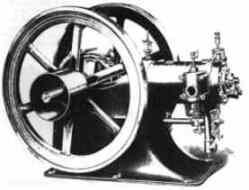
|
| Volume Governing means regulating
the force of the impulse by controlling the amount of each charge.
This does not mean reducing or regulating the number of explosions
in the cylinder. Where power is wanted for work requiring close speed
regulation, constant or custom service, with maximum reliability,
the R&V Volume Governing Engines should be sold. This type is
unequaled for use in electric lighting plants, machine shops, creameries,
cotton gins, custom shelling, grinding or feed cutting. The
"R & V" Horizontal Engine, volume governing, is of
the four cycle type, especially designed to meet the requirements
of those wanting a strictly high-grade machine. We offer this engine
as an exceedingly reliable and durable motor for all power purposes.
It is now generally conceded that oil engines in small and medium
powers are more economical, convenient, and safer. They require
less attention, and in other respects are superior to steam power. |
| 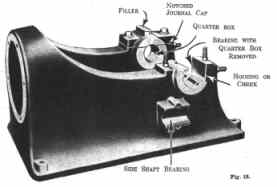
|
Bed: The bed
is of the center crank - box
type, with unusually heavy housings between cylinder and bearings.
There are no exposed ribs thus giving a very smooth outline. The top
surface of the housings are well above the center line of the engine,
thus insuring a very rigid frame. The massive proportions of this
bed are shown in the above illustration. |
Main Journals:
These journals are of the quarter box type, lined with genuine Babbitt,
penned, bored and hand-scraped to size.
The cheeks which receive the thrust are adjustable to compensate for
wear, and thus preserve original alignments. The journal caps are
notched over the frame, forming a rigid tie between housing and journal
support, as clearly shown. Under the journals are cored chambers,
which contain the lubricant for automatically oiling the main journals
by means of a chain oiler. |

|
| Igniter:
Of the two forms of ignition in present-day use, the jump spark and
make-and-break, we have adopted the make-and break system, as it possesses
numerous advantages over the jump spark. It requires no high-tension
current, hence is not liable to trouble from short circuits, requires
no finely adjusted coil, makes a larger, fatter spark and has proven
itself generally more reliable and free from trouble or break-downs
than the jump spark. The term "make-and-break" has been
applied to this system because when the igniter is tripped, the two
electrodes are first brought together inside of the cylinder and make
or close the electric circuit. Immediately following, these two points
are suddenly drawn apart, breaking the circuit and producing the spark,
it being an electrical fact that on closing a circuit there is no
spark and upon breaking it a spark is produced. Current is being used
only while the electrodes are in contact which is a very short space
of time. Hence the igniter is economical in current consumption. The
igniter is placed in the center of the cylinder head. All parts are
made from drop forgings except the trip, which is of tool steel. The
electrodes are of the hammer type, capped with special points that
are extremely durable, thus assuring a good, strong spark for over
a year's continuous use. The igniter trip is very simple, positive
in action, not f liable to get out of order, requires no r delicate
adjustment, and is practically noiseless. When desired, a device for
advancing the spark is furnished with these engines as an extra. |
| Volatilizer:
During exceptionally cold weather, gasolene will not readily
gasify, which under ordinary conditions causes more or less trouble
in getting engine to start. To overcome this, we now furnish a volatilizer
screwed to the exhaust box cap on all Horizontal Volume Governing
Engines of 5hp and larger. In addition we furnish a heater tray attached
underneath the inlet air pipe, thus making it possible to start all
sizes of engines under any conditions of weather and in all temperatures.
|

|
| Batteries:
We furnish each of our engines with the best and most approved
type of battery that the market affords, as so many engine failures
are traced to a poor quality battery. Fittings:
These are of the best quality we can buy. All small details of construction
receive the most exact and careful attention.
Accessories:
One set of Edison-Lalande batteries, consisting of five type"RR"
cells with spark coil and switch all substantially boxed, or a magneto.
Gasolene tank with pipe and fittings. Muffler, exhaust pipe. Oil
can. One monkey wrench and two connecting-rod wrenches. Also an
instruction book for setting up. starting and taking care of engine. |
| Edison Spark Coil
In order to obtain a bright, hot
spark, which will unfailingly ignite the explosive mixtures in the
combustion chamber, a good spark coil must be used in connection
with a battery. |
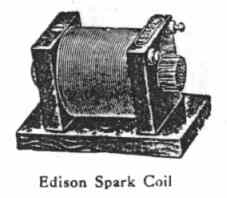
|
| 
|
Type "RR" Cell: For stationary
engines. Large gas engine model. Capacity 300 ampere-hours. We recommend
five of these cells for stationary engines, as it develops a strong,
constant current continuously, no attention being necessary until
the entire charge is exhausted. They do not waste while idle, are
simple in construction. Complete Cell with porcelain jar, $5.80.
| Price
of renewal parts
1 Zinc plate (capacity,
1 charge) $1.00 1 Copper Oxide plate (1 charge) $1.10
1 Can Caustic Soda (1 charge) $0.56c 1 Bottle heavy paraffin
oil (1 charge) .56c
Total ----------------------------$2.80 |
|
| 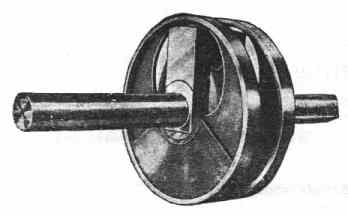 Crankshaft. Crankshaft.
The crankshaft is turned from a
solid steel forging and counter-balanced with weighted discs securely
bolted to the webs of the crank, thus counter-weighting the crank
and reciprocating parts at the crank rather than in the rim of the
balance wheel, as is common gas engine practice. We consider this
system of counter-weighting the most correct method as it brings
the strains directly on the crank rather than through the shaft,
and in high speed work assures a much smoother running engine. The
construction of the crank shaft is clearly shown in the illustration. |
| 
|
| 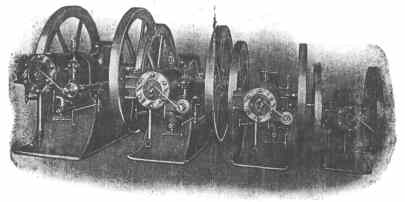
A group of Horizontal Volume
Governed Engines. |
| 
|
| This is a later version of the Volume Governing
Engine using a detachable water hopper.. It came in hopper or tank
cooled. While this style of engine is
higher in price than the Triumph and similar engines, the volume
governing engines is practically in a class by itself and possesses
a distinct individuality because few manufacturers of engines make
anything of the kind. |
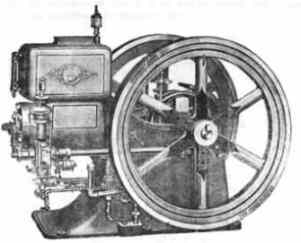 |
| 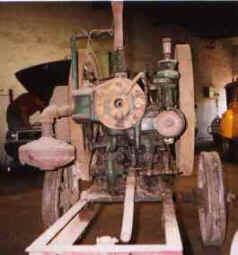
|
 As found
As found |
| 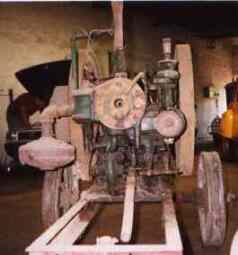
 The finished job
The finished job
This particular engine, above, uses
a high tension magneto (Bosch) and spark plug, possibly used on
export models for better reliability away from the ready availability
of factory spare parts. The USA version, from factory photographs,
show low tension ignitor and battery setup, although a magneto is
mentioned. Batteries of the day, made with glass cases, would have
been fragile to transport overseas.
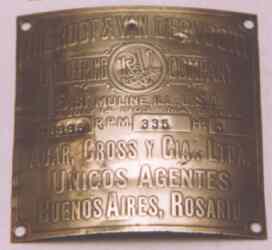 R&V tag with name of agent
in Argentina.
R&V tag with name of agent
in Argentina.
The 3 photos above and the tag
are from a 3hp Volume Governed R&V engine from Argentina. #08885
Any communication to owners of R&V engines can be made through
Site Custodian.
Official R&V Web Site © 2000 - 2023
|
|

